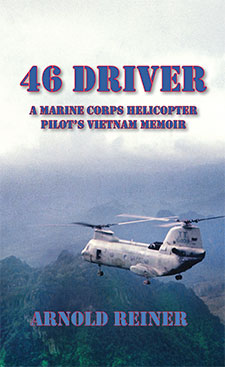Release #: Vol. 85, No. 2
March 01, 2016
Book Review: 46 Driver
By Capt. Arnold Reiner (Delta, Ret.)
On Aug. 1, 2015, a young U.S. Marine Corps pilot delivered a Boeing Vertol CH-46 tandem rotor helicopter—the very airframe her father flew in the early days of the Vietnam War—to the National Air and Space Museum’s Steven F. Udvar-Hazy Center in Chantilly, Va., on the south side of Washington Dulles Airport.
In dignified ceremonies marking the end of an astonishing 51 years of CH-46 service in the U.S. Navy and Marine Corps, the helicopter was added to the Udvar-Hazy’s exhibits.
Capt. Arnold Reiner (Delta, Ret.) was there.
He might not have been.
Consider this excerpt from Reiner’s 46 Driver: A Marine Corps Helicopter Pilot’s Vietnam Memoir: “An axiom in war is to avoid repetition. Don’t go out the way you came in, and don’t go in the same way twice. Unfortunately, there’s often no alternative, and in such circumstances there often are consequences, especially if the repetition isn’t the route but the point over which a helicopter must hover.
“…[A]round came through the nose, striking Jim’s rudder pedal. Another came through the floor by my collective pitch lever, splintering, striking my left elbow and destroying my wristwatch, which was in my left arm pocket. The round continued into the cockpit overhead and stopped in the forward transmission housing.”
Reiner and his crew escaped the ground fire; later, a corpsman picked most of the shrapnel out of his elbow, where several specks remain today.
Designated a naval aviator in 1965, Reiner joined Marine Medium Helicopter Squadron HMM-265, which had recently received the new CH-46A helicopters and deployed to Vietnam in April 1966. He later served in-country with HMM-164. During his Vietnam tour, Reiner was awarded the Purple Heart, 11 Air Medals, the Vietnam Gallantry Medal, and the Vietnam Service Medal.
After serving his hitch, Reiner joined Pan American World Airways as a B-707 first officer. Eventually he became director of flight safety at Pan Am and a B-727 and A310 captain. He retired from Delta in 2000.
One of Reiner’s central themes in 46 Driver is that “human error and mechanical failure are as dangerous as the enemy, often more so.” The earliest version of the CH-46, the A model, “was a militarized and somewhat beefed-up version of the Boeing Vertol 107 civilian helicopter which wasn’t designed for the stresses of military flying, and its mechanical shortcomings would become apparent in the years ahead. Eventually its flaws would be corrected through structural and mechanical modifications, but the learning curve was deadly.”
Reiner explains that the Navy called the CH-46A the Sea Knight, but no Marines called it that; the nickname “Phrog,” a nod to the CH-46’s squat appearance (well, at least it looked as though it could leap off the ground!) was yet to come. “During my time in the Marines,” he recalls, “in response to the question, ‘What do you fly?’ the answer was simply, ‘Forty-sixes.’”
The CH-46 was even more of a (double) handful than other helicopters: “The normally simple act of taxiing was an unexpected and surprising challenge. Because of the helicopter’s tandem rotor configuration, taxiing required a deft combination of cyclic and collective inputs sometimes coupled with differential braking.”
On top of all that, Reiner and his brothers in arms took these new helos, with inadequately trained mechanics, to a war zone that was hot, humid, salty, and sandy—the latter condition in particular taking its toll on rotary-wing aircraft.
46 Driver takes the reader back into those sweaty, gritty, bloody days but also includes Reiner’s perhaps surprising long view of the Vietnam War and Vietnam’s past, present, and future.
This article is from the March 2016 issue of Air Line Pilot magazine, the Official Journal of the Air Line Pilots Association, International—a monthly publication for all ALPA members.-###-

